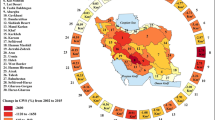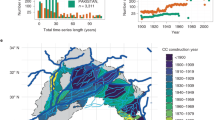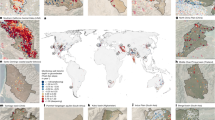Abstract
The majority of naturally occurring freshwater on small islands is groundwater, which is primarily recharged by precipitation1. Recharge rates are therefore likely to be impacted by climate change2. Freshwater resources on small islands are particularly vulnerable to climate change because they are limited in size and easily compromised3,4,5. Here we have compiled available aquifer system characteristics and water-use data for 43 small island developing states distributed worldwide, based on local expert knowledge, publications and regional data sets. Current vulnerability was assessed by evaluating the recharge volume per capita. For future vulnerability, climate change projections were used to estimate changes in aquifer recharge. We find that 44% of islands are in a state of water stress, and while recharge is projected to increase by as much as 117% on 12 islands situated in the western Pacific and Indian Ocean, recharge is projected to decrease by up to 58% on the remaining 31 islands. Of great concern is the lack of enacted groundwater protection legislation for many of the small island developing states identified as highly vulnerable to current and future conditions. Recharge indicators, shown alongside the state of legal groundwater protections, provide a global picture of groundwater supply vulnerability under current and future climate change conditions.
This is a preview of subscription content, access via your institution
Access options
Subscribe to this journal
Receive 12 print issues and online access
$209.00 per year
only $17.42 per issue
Buy this article
- Purchase on Springer Link
- Instant access to full article PDF
Prices may be subject to local taxes which are calculated during checkout


Similar content being viewed by others
References
Hydrology and Water Resources of Small Islands: A Practical Guide (ed. Falkland, A.) (UNESCO, 1991).
Green, T. R. et al. Beneath the surface of global change: impacts of climate change on groundwater. J. Hydrol. 405, 532–560 (2011).
Climate Change and Water (eds Bates, B. C., Kundzewicz, Z. W., Wu, S. & Palutikof, J. P.) (IPCC Secretariat, 2008).
IPCC Climate Change 2013: The Physical Science Basis (eds Stocker, T. F. et al.) (Cambridge Univ. Press, 2013).
IPCC Climate Change 2014: Impacts, Adaptation, and Vulnerability (eds Barros, V. R. et al.) (Cambridge Univ. Press, 2014).
Robins, N. S. A review of small island hydrogeology: progress (and setbacks) during the recent past. Q. J. Eng. Geol. Hydrog. 46, 157–165 (2013).
UNESCO-IHP, IGRAC, WWAP Transboundary Aquifers and SIDS Groundwater Systems: Methodology and Execution Arrangements (UNESCO, 2012); http://isarm.org/sites/default/files/resources/files/TWAP%20Methodology%20Groundwater%20Component%20(Revised%20Aug%202012).pdf
Allen, D. M. et al. Assessment of SIDS Groundwater Systems, Transboundary Water Assessment Programme (Simon Fraser University, 2014); http://isarm.org/sites/default/files/resources/files/Assessment%20of%20SIDS%20Groundwater%20Systems%20-%20Final%20Report.pdf
UNESCO-IHP and UNEP Transboundary Aquifers and Groundwater Systems of Small Island Developing States: Status and Trends, Summary for Policy Makers (UNEP, 2016); http://www.geftwap.org/publications/groundwater-spm
Global Groundwater Information System (GGIS) (IGRAC, 2016); https://www.un-igrac.org/global-groundwater-information-system-ggis
Revenga, C. Pilot Analysis of Global Ecosystems: Freshwater Systems (World Resources Institute, 2000); http://pdf.wri.org/page_freshwater.pdf
Karnauskas, K. B., Donnell, J. P. & Anchukaitis, K. J. Future freshwater stress for island populations. Nat. Clim. Change 6, 720–725 (2016).
McSweeney, C., New, M., Lizcano, G. & Lu, X. The UNDP climate change country profiles. Bull. Am. Meteorol. Soc. 91, 157–166 (2010).
Schroeder, P. R. et al. The Hydrologic Evaluation of Landfill Performance (HELP) Model: Engineering Documentation for Version 3 Report No. EPA/600/R-94/168b (US Environmental Protection Agency, 1994).
Scibek, J. & Allen, D. M. Modeled impacts of predicted climate change on recharge and groundwater levels. Wat. Resour. Res. 42, W11405 (2006).
Jyrkama, M. I. & Sykes, J. F. The impact of climate change on spatially varying groundwater recharge in the grand river watershed (Ontario). J. Hydrol. 338, 237–250 (2007).
Toews, M. W. & Allen, D. M. Evaluating different GCMs for predicting spatial recharge in an irrigated arid region. J. Hydrol. 374, 265–281 (2009).
Allen, D. M., Cannon, A. J., Toews, M. W. & Scibek, J. Variability in simulated recharge using different GCMs. Wat. Resour. Res. 46, W00F03 (2010).
FAO/UNESCO Soil Map of the World (FAO, accessed 1 January 2014); http://www.fao.org/soils-portal/soil-survey/soil-maps-and-databases/faounesco-soil-map-of-the-world/en.
Freeze, R. A. & Cherry, J. A. Groundwater (Prentice-Hall, 1979).
Gleeson, T. et al. Mapping permeability over the surface of the Earth. Geophys. Res. Lett. 38, L02401 (2011).
Richardson, C. W. & Wright, D. A. WGEN: A Model for Generating Daily Weather Variables Report ARS-8 83 (Agricultural Research Service, USDA, 1984).
Climate Change Knowledge Portal (World Bank Group, accessed 1 January 2014); http://sdwebx.worldbank.org
UNdata (WMO, accessed 1 January 2016); http://data.un.org/Explorer.aspx?d=CLINO
Climate Change Country Profiles (UNDP, 2010).
Nakicenovic, N. et al. Special Report on Emissions Scenarios (IPCC, Cambridge Univ. Press, 2000).
Acknowledgements
Funding for this research was provided by UNESCO through the Small Island Developing States Transboundary Water Assessment Programme. The questionnaire distributed to local experts was co-developed with the International Groundwater Resources Assessment Centre (IGRAC). IGRAC also coordinated data and information management for the TWAP Groundwater Assessment Programme. The authors thank J. Gurdak and M. Taniguchi for their assistance in reviewing and refining the research approach.
Author information
Authors and Affiliations
Contributions
S.H. and D.M.A. designed the assessment, compiled the data and analysed the results. S.F., A.H., I.L., J.K. and S.C.V.P. conducted the literature review.
Corresponding author
Ethics declarations
Competing interests
The authors declare no competing financial interests.
Supplementary information
Supplementary Information
Supplementary Information (PDF 375 kb)
Rights and permissions
About this article
Cite this article
Holding, S., Allen, D., Foster, S. et al. Groundwater vulnerability on small islands. Nature Clim Change 6, 1100–1103 (2016). https://doi.org/10.1038/nclimate3128
Received:
Accepted:
Published:
Issue Date:
DOI: https://doi.org/10.1038/nclimate3128
This article is cited by
-
The impacts of climate change on coastal groundwater
Nature Reviews Earth & Environment (2024)
-
Effects of land-cover and watershed protection futures on sustainable groundwater management in a heavily utilized aquifer in Hawai‘i (USA)
Hydrogeology Journal (2021)
-
Groundwater recharge to a structurally complex aquifer system on the island of Tobago (Republic of Trinidad and Tobago)
Hydrogeology Journal (2021)
-
Large-scale hydraulic conductivity distribution in an unconfined carbonate aquifer using the ocean tidal propagation
Hydrogeology Journal (2021)
-
Regional and well-scale indicators for assessing the sustainability of small island fresh groundwater lenses under future climate conditions
Environmental Earth Sciences (2020)



